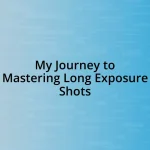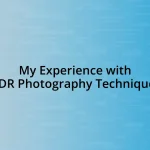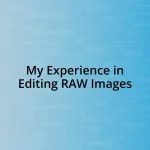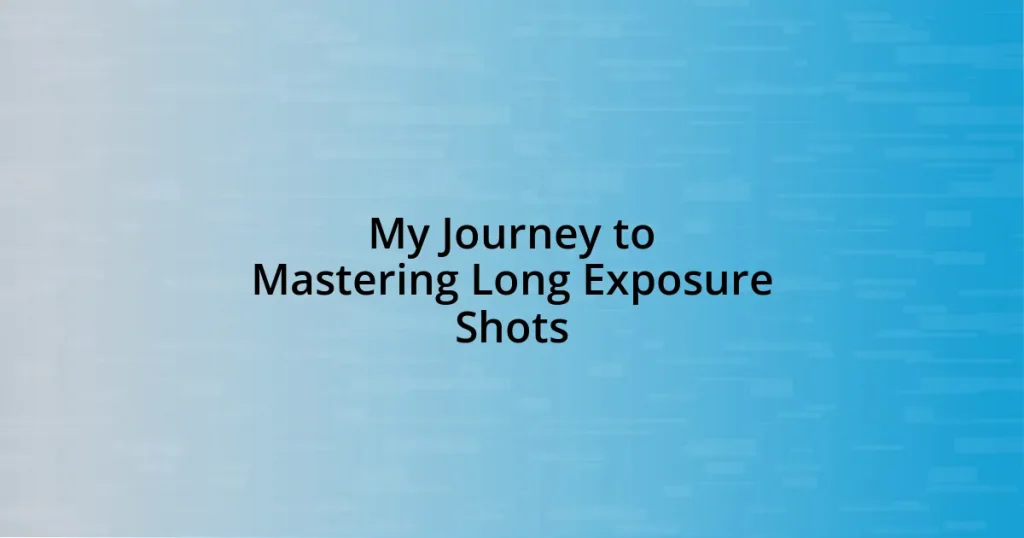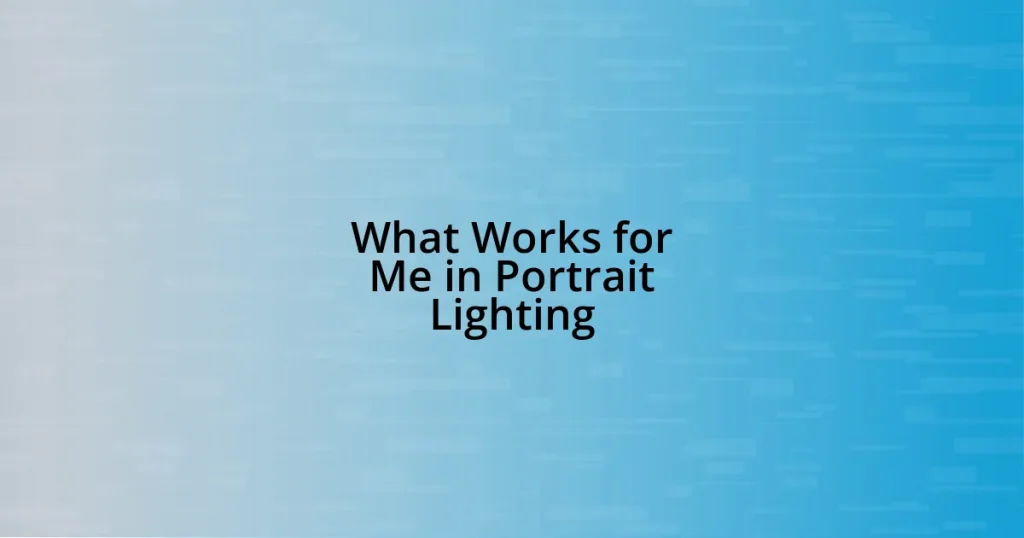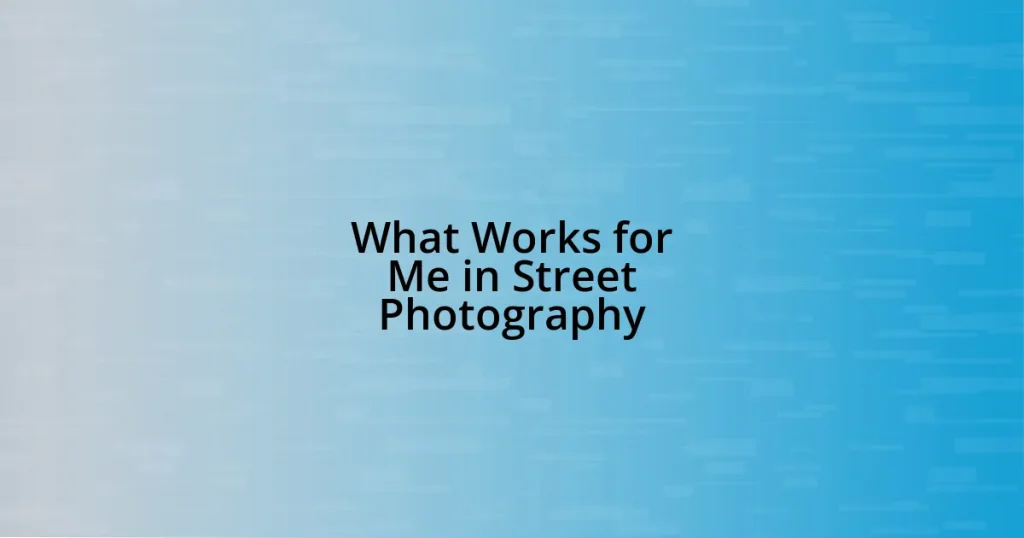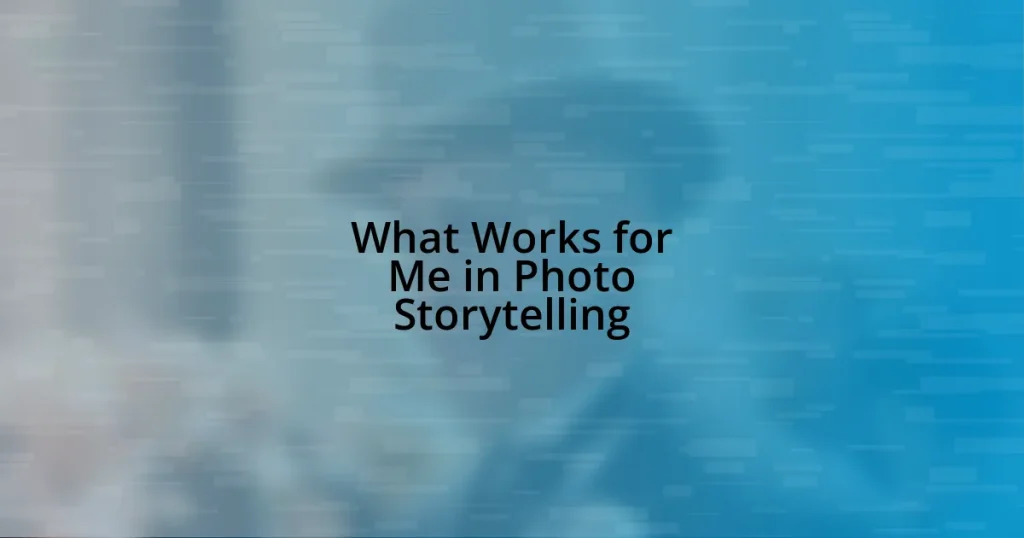Key takeaways:
- Long exposure photography captures time and movement, creating a dynamic visual story that combines serenity and energy.
- Essential gear includes a sturdy tripod for stability, a neutral density filter for controlling light, and a remote shutter release to minimize camera shake.
- Successful long exposure shots require patience and technique, such as low ISO settings, timing during the golden hour, and creative shutter speed experimentation.
- Post-processing enhances images by adjusting contrast, clarity, and composition to evoke emotions and improve overall impact.
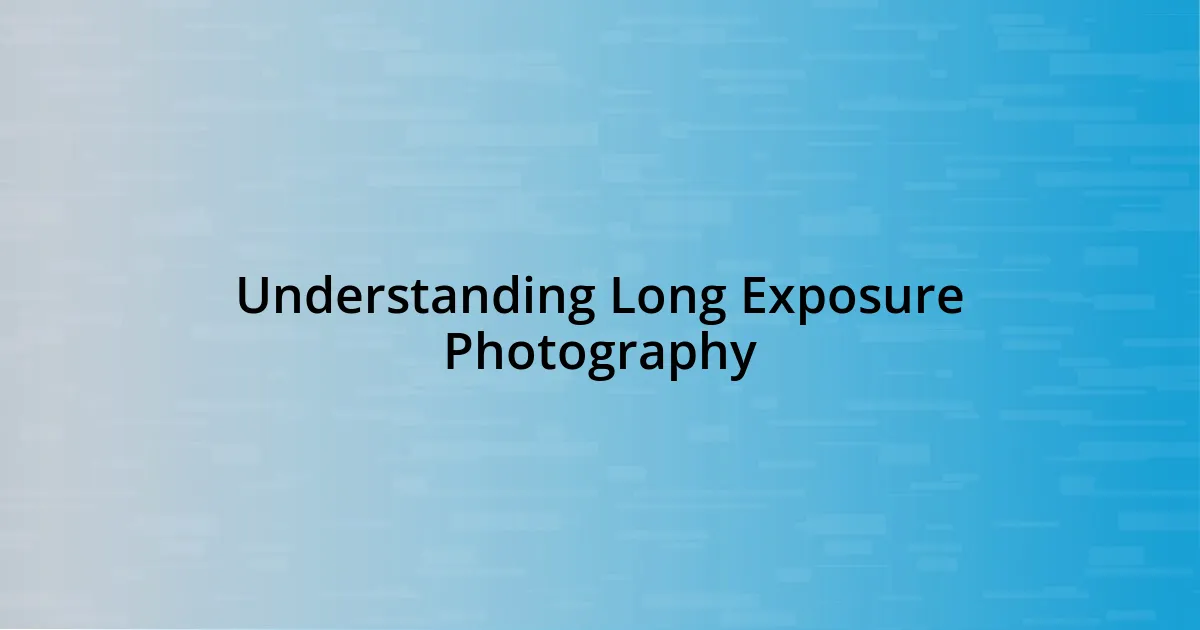
Understanding Long Exposure Photography
Long exposure photography is all about capturing the passage of time within a single image. I remember the first time I experimented with this technique; standing at a quiet lakeside just before dawn, I was mesmerized by how the still water mirrored the soft hues of the sky. Have you ever noticed how motion can transform your perception of a scene?
By using slow shutter speeds, you allow moving elements—like flowing water or bustling city life—to blur into ethereal streaks. I find that this creates a sense of movement that static images often lack. It still amazes me how a simple drop of time can encapsulate both serenity and energy in one frame.
Understanding the technical side, like aperture and ISO settings, is crucial, but the real magic happens when I connect emotionally with my subject. Each long exposure shot tells a story, revealing aspects of a location that we might overlook in the haste of everyday life. Have you ever lingered on a scene, feeling its pulse as you pressed the shutter? That feeling of connection is why I love long exposure photography.

Essential Gear for Long Exposure
When embarking on the journey of long exposure photography, having the right gear is essential. A sturdy tripod is my trusted companion, providing the stability needed to capture those extended frames without any camera shake. I still remember my first outdoor shoot; I ended up using a makeshift setup because I didn’t have one. That lesson taught me the importance of investing in a solid tripod—it’s a game changer.
Another crucial item in my kit is a neutral density (ND) filter. This little gadget allows me to reduce the amount of light entering the lens, enabling longer exposure times even during bright daylight. I recall a day at the beach, experimenting with an ND filter while photographing waves crashing against the rocks. The smooth, surreal water created an almost painterly effect that I couldn’t have achieved without it. It’s fascinating how the right filter can unlock creative possibilities that completely redefine the image.
Lastly, my trusty remote shutter release has saved me countless times from the perils of camera shake. It gives me control over the shutter without physically touching the camera, which can be especially helpful during longer exposures. There’s something satisfying about being able to set up an entire scene and then step back, letting the camera do the work while I focus on the experience around me. Each piece of gear contributes to my vision, turning moments into breathtaking images.
| Gear | Purpose |
|---|---|
| Tripod | Stability to avoid camera shake |
| Neutral Density Filter | Reduce light for longer exposures |
| Remote Shutter Release | Minimize shake during shooting |

Techniques for Successful Long Exposure
When it comes to mastering long exposure shots, patience is key. I remember one evening, waiting in a bustling city square, the lights flickering as people moved by. I had set up my camera to capture the traffic, and as I looked through the viewfinder, the world transformed into a tapestry of glowing streaks. It’s in those still moments of waiting that you truly connect with your subject and anticipate how they will unfold over time.
A few techniques that consistently yield great results include:
- Use a low ISO: Keeping my ISO low helps maintain image quality by minimizing noise.
- Timing your shot: I often rely on the golden hour, where natural light adds that magical touch to my photos, enhancing the glow of the moving elements.
- Experiment with shutter speed: I enjoy trying out various shutter speeds, sometimes just a few seconds for slight motion or several minutes for dreamy effects.
Finding the balance between time and technique can be remarkably rewarding in the final image.
Creating smooth, silky effects, especially with water, is another exciting aspect of long exposure photography. Once, while photographing a waterfall, the sound of rushing water surrounded me, a healing presence in that moment. The key here is utilizing long shutter speeds to blur the water’s motion, turning it into a soft veil that frames the rocks beautifully. A few fundamental practices help achieve that stunning look:
- Position your camera at the right angle: The location drastically impacts how the water flows in the frame.
- Check the weather: A cloudy day can soften the harsh light, allowing for more extended exposures without blown-out highlights.
- Leverage the environment: I often look for framing elements, such as trees or rocks, which guide the viewer’s eye and enhance the storytelling.
There’s joy in experimentation, each frame capturing a unique story influenced by my environment and perspective.

Choosing the Right Locations
Finding the perfect location for long exposure photography can elevate your images to another level. I remember standing on a quiet beach at dawn, the world still veiled in a soft blue haze. The waves gently lapping at the shore created a rhythm that pulled me into the moment—I knew this was the right place for capturing that ethereal water effect.
Cities offer excitement, but you’ll want to choose spots with light movement for captivating results. I once found myself at a bustling bridge, watching the cars rush beneath as the sun dipped below the horizon. The way the headlights turned into bright trails reminded me of shooting stars, bringing an unexpected sense of wonder amidst the urban chaos. Have you ever experienced that magical transformation where motion paints the scene differently? It’s a beautiful reminder of what long exposure can do.
Nature scenes are often a goldmine for stunning long exposures. When I hiked to a secluded waterfall, I felt a rush of anticipation as I set up my camera. The silky water cascading over the rocks turned the ordinary into something extraordinary, and the sound of the rushing water became my muse. Choosing locations that speak to you, whether it’s tranquility in nature or vibrant city life, can profoundly impact your long exposure journey. What inspires you to pick one spot over another? For me, it’s that instinctual pull that always leads me to my best work.
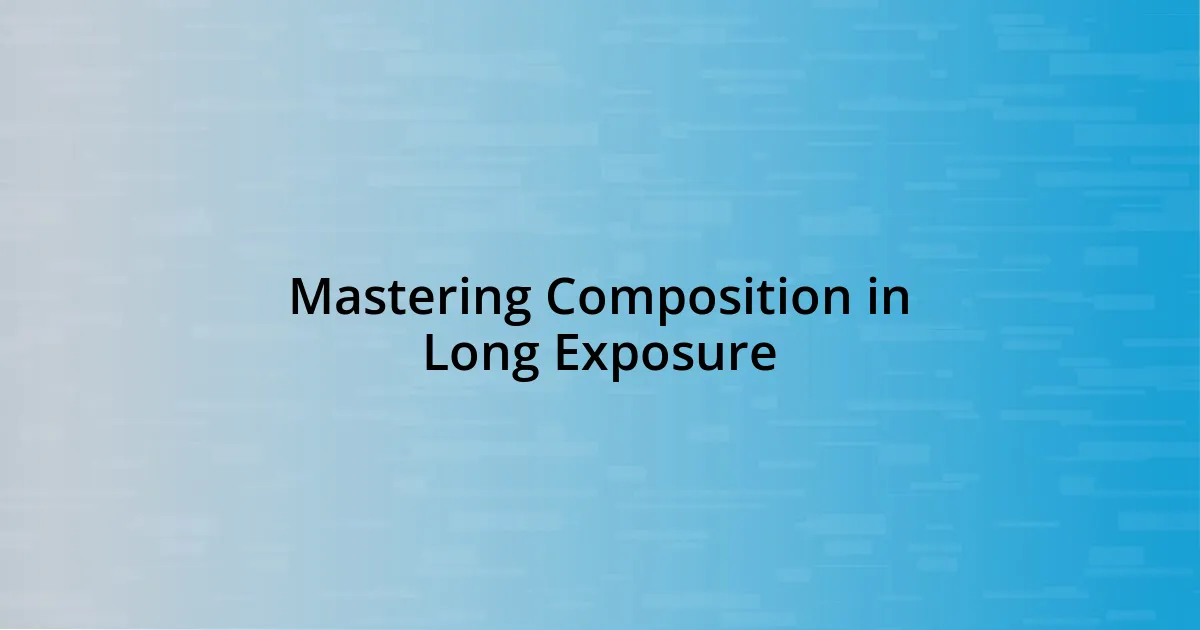
Mastering Composition in Long Exposure
Mastering composition in long exposure photography is about more than just timing; it’s about creating visual stories. I recall a moment at a calm lake during twilight, where I focused not just on the water but also on the surrounding forest. By placing the trees at the edges of the frame, I created a natural border that led the viewer’s eye toward the shimmering reflections. Isn’t it fascinating how the simplest adjustments can profoundly change a shot’s impact?
Finding leading lines can also dramatically enhance a composition. While experimenting at an old train station, I positioned my camera to capture the tracks extending into the horizon. The endless lines drew my gaze deeper into the image, inviting thoughts of journeys and adventures. Have you ever noticed how such elements can make your viewer pause longer? It’s almost as if the photograph whispers stories waiting to be told.
Lastly, incorporating the human element can add a unique dynamic to long exposures. One evening, while photographing busy streets, I set up for a shot where pedestrians were in constant motion. Their fleeting forms contrasted beautifully with the static buildings, emphasizing the vibrant life of the city. Isn’t it interesting how blending stillness with movement creates a rhythm in your images? This interplay enriches not only the composition but also the emotions conveyed, connecting the audience with the scene on a deeper level.
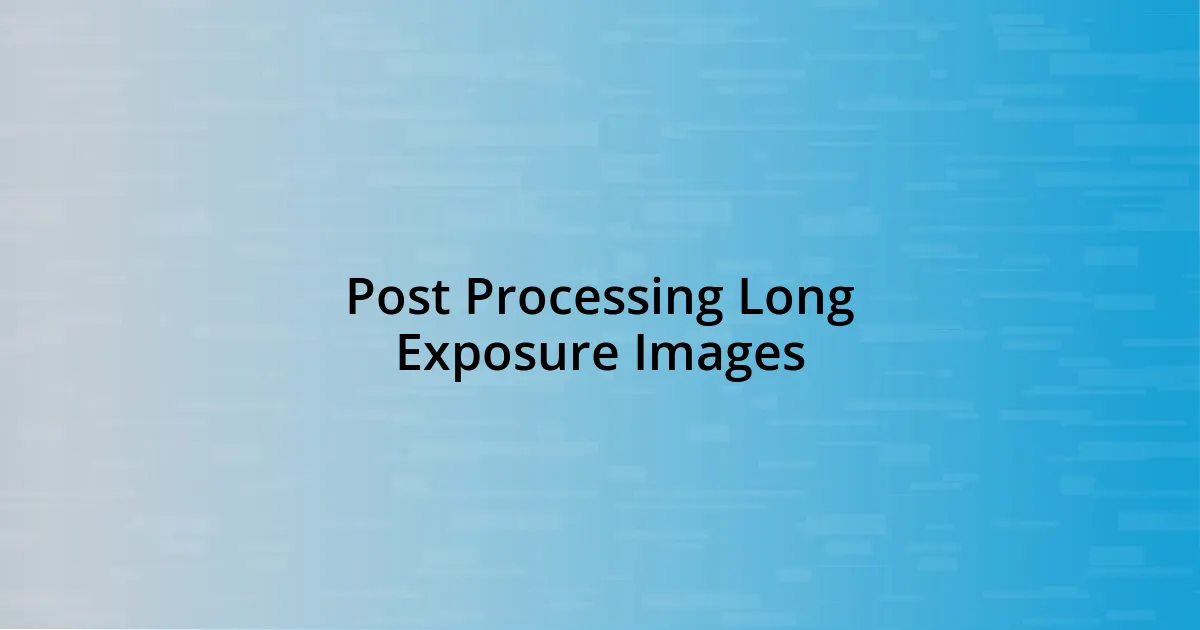
Post Processing Long Exposure Images
Post-processing long exposure images is where the magic truly begins for me. I often find myself diving into Lightroom or Photoshop, eager to transform what I’ve captured into a mood that resonates with the feel of the moment. For instance, while editing a photo of a sunset over the ocean, I adjusted the highlights and shadows to bring out the fiery colors, mimicking how I remember the sky exploding with warmth. Have you ever tried pulling those vibrant colors forward to evoke a specific emotion?
I also love playing with contrast and clarity to emphasize the silky textures of moving water in my long exposure shots. I recall editing a picture of a serene waterfall, where a slight increase in clarity made the droplets come to life. It’s incredible how a simple adjustment can feel like adding a spark of energy to the scene. What little tweaks make your images stand out, turning them into visual memories that linger in your viewer’s mind?
Lastly, I can’t stress enough the importance of cropping. Sometimes, during editing, I’ll discover that a small tweak in framing can elevate an image significantly. I once cropped an urban shot that initially felt chaotic; clarity emerged when I cut away distracting elements, allowing the flowing light trails from cars to take center stage. Isn’t it interesting how a fresh perspective can shift our understanding of a scene? These small yet powerful changes in post-processing can make your long exposure images genuinely captivating.

Tips for Perfecting Your Shots
When it comes to perfecting long exposure shots, I’ve found that stability is key. Using a sturdy tripod can make all the difference. I once had a shaky experience at a windy cliffside, and my images turned out blurred and disappointing. Ensuring your camera is anchored means the world to your results. Have you ever lost a shot due to vibration or movement? It can be disheartening, can’t it?
Another crucial tip is to experiment with exposure times. I recall a night when I was capturing light trails from passing cars; I started with a 10-second exposure but quickly discovered that extending it to 30 seconds created ethereal light ribbons that danced across the frame. It felt like the cars were leaving behind traces of their journeys, transforming the ordinary into the magical. Don’t you think those longer exposures can elevate the storytelling aspect of a photograph?
Lastly, pay attention to your settings. I often start with a low ISO and a smaller aperture to maintain image clarity. One evening while photographing a tranquil beach, I found that using an aperture of f/11 resulted in razor-sharp details both in the water and the sky. It’s amazing how adjusting these elements allows you to control the depth of field. What settings do you find work best for you in creating stunning long exposures? Finding the right combination can feel incredibly rewarding!






